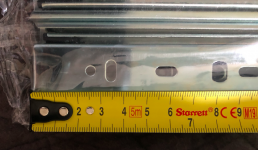Rick Herrick
Member
- Joined
- Feb 7, 2020
- Messages
- 811
My current project gave me my first time to do drawer slides. I also had some adjustable shelves. To me, shelf pins need holes and drawer slides need holes, both completely different (to me at least). But I have seen past posts here and been watching a lot of YT videos. What caught my eye this weekend is a guy was using his LR32 to create his holes so that he could use either slides or pins????
So my question is, can the holes created by the LR32 (or any hole boring method I guess) be used for both pins and slides? Just looking for clarification as I would never expect either a 1/4" or 5mm shelf pin hole to be useable by a drawer slide. Thank you.
So my question is, can the holes created by the LR32 (or any hole boring method I guess) be used for both pins and slides? Just looking for clarification as I would never expect either a 1/4" or 5mm shelf pin hole to be useable by a drawer slide. Thank you.


